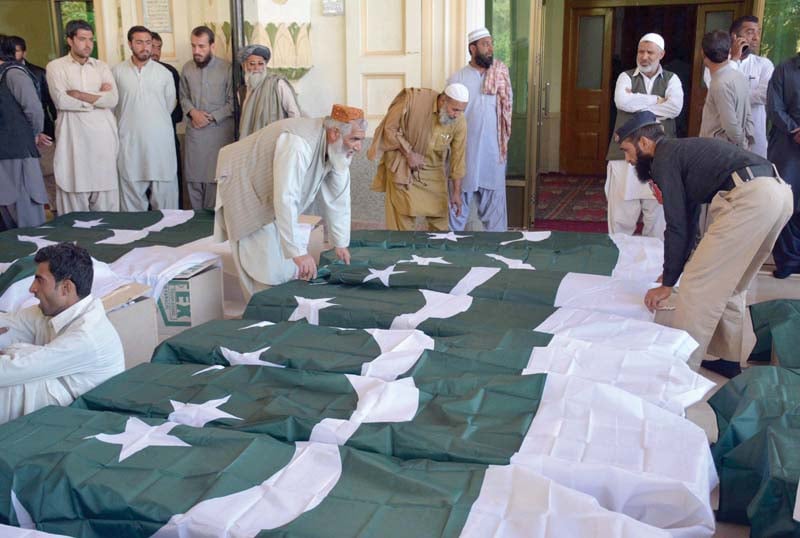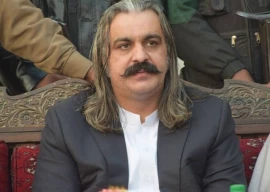
61 killed, at least 165 injured as militants storm police training centre in Quetta
The deadly gun and suicide attack raised some stinging questions: how did the terrorists get into the facility where hundreds of cadets were under training? Why is the casualty figure so high while security forces responded well in time?
Officials concede security at the sprawling compound was not up to the mark. The terrorists scaled the mud-built peripheral wall of the college almost unchallenged before heading straight for the hostel where some 700 recruits were preparing for bed after day’s rigorous training.
Notwithstanding the fact it is located in a highly sensitive area where security forces frequently carry out raids, the training centre was surprisingly almost unguarded.
The terrorists first took down a lone tower sentry before accessing the grounds, according to Home Minister Mir Sarfaraz Bugti, who surprisingly refused to shoulder responsibility for security lapse.
Defence minister tweets cryptic message linking PTI dharna to Quetta attack
“They [terrorists] came in by jumping over the walls of the academy which are very low. I ran away from my room and was hit by a bullet, I still managed to flee,” 22-year-old cadet Hikmatullah recalled while speaking from his hospital bed where he was recuperating from a gunshot wound to the left shoulder.
Officials say there could be more than one possible reason for the high death toll. Once inside the facility, the terrorists fired randomly, killing anyone and everyone they caught sight of. They also threw incendiary bombs prepared with deadly chemicals.
The recruits were killed like sitting ducks because they were unarmed and could not put up a fight. The terrorists headed straight for the living quarters where they killed the policemen guarding the main gate before entering the living rooms. Survivors say the terrorists tricked cadets hiding in their rooms into opening locked doors by pretending to be soldiers.
Quetta police academy attackers 'pretended to be soldiers': witnesses
“They entered the rooms one by one. They went in one room and fired inside it, then they went in another,” said Hikmatullah. “They also knocked at the locked rooms and told the cadets that they were from the army, and when they opened the doors, they fired at them,” he added.
The methodical killing created chaos in the building. Cadet Zubair Ahmed said: “Some people were jumping out of windows, others were trying to climb out onto trees. I also jumped out of a window via a tree and injured my shoulder and foot. I lay on the ground injured for one hour till I was rescued.”
Cadet Muhammad Sabar, who belongs to Turbat, said the deadly assault started around 11 in the night when they were preparing to sleep. “Suddenly, two terrorists came in and opened indiscriminate fire. When they ran out of bullets, they lobbed hand grenades and later one of them detonated his suicide vest.”
In pictures: Militants storm police training centre in Quetta
Cadet Hamza said that when the terrorists got inside the hostel and started going room to room to kill the recruits, they locked themselves in their barracks. “We piled our chests, cots and whatever we could find against the door to prevent the terrorists from getting in,” he told The Express Tribune.
“They kicked the door to break it open but couldn’t. Then they went to barrack no 3 which is right opposite our barracks. And we heard crackle of gunshots followed by a deafening blast which, I believe, was when one of the attackers blew himself up.”
Officials said two of the terrorists detonated the explosives strapped to their bodies, while the third was taken down by army and Frontier Corps commandos in an operation that continued for four hours while senitisation of the compound continued into Tuesday.
“Two terrorists blew themselves up in the hostel, while the third was shot dead by commandos before he could trigger his suicide vest,” Bugti said.
PM, army chief attend security meeting following Quetta attack
The facility remained sealed to journalists but mobile video footage shot by an intelligence official showed the hollowed remains of a large dormitory hall covered in thick black soot. All the bedding and belongings in the room had apparently burnt and been reduced to ashes, while a deep crater in the floor showed where one of the three attackers had detonated his suicide vest.
IG FC Major General Sher Afgun blamed the deadly assault on the Lashkar-e-Jhangvi (LeJ) sectarian terrorist group. An emailed claim from the proscribed Tehreek-e-Taliban Pakistan, which shares close operational ties with the LeJ, backed that assertion.
“This attack was carried (out on the instructions of) Mullah Daud Mansour, close ally of Hakimullah Mehsud and head of TTP in Karachi,” it said, adding four fighters took part. The surviving cadets say the attackers were speaking Persian.
The Islamic State group also made a claim via Amaq, its affiliated news agency, and released a picture of what it said were the three attackers. The LeJ officially pledges allegiance to al Qaeda, the IS group’s major rival. But the dual claims could be evidence of new linkages that remain unofficial, analysts say.
The casualties were driven to the Civil Hospital Quetta, Bolan Medical College Teaching Hospital and Combined Military Hospital where medics said 12 of them were being treated for life-threatening wounds.
Military officials confirmed that a captain of Pakistan Army and a petty officer of FC were among the dead. They identified them as Captain Roohullah Mohmand and Subedar Muhammad Ali.
Most of the deceased cadets belonged to Turbat, Panjgur, Chaman, Pishin, Naseerabad, Loralai and other districts of Balochistan. Thirty-four cadets hailed from Mekran region alone.
Maj Gen Afgun said the terrorists were receiving instructions from neighbouring Afghanistan. He added that his force received information about the attack at 11:10 pm and immediately army and FC commandos were sent to secure the facility. By the time, the commandos cordoned off the area, one of the terrorists had already blown himself up. He refused to share details.
Army chief General Raheel Sharif, along with DG ISI Lt Gen Rizwan Akhtar, flew into Quetta and headed straight to the police academy where he was briefed on the deadly attack. They also joined Prime Minister Nawaz Sharif, Chief Minister Sanaullah Zehri and other senior government officials at an official funeral for the victims, whose bodies were placed in coffins draped in white and borne by soldiers in dress uniform.
The attack was the third biggest in Pakistan this year and a grim reminder that for all its gains in its long battle against a homegrown Islamist insurgency, militants are still able to strike serious blows against top state institutions.
Published in The Express Tribune, October 26th, 2016.






1732776427-0/Express-Tribune-(1)1732776427-0-270x192.webp)

1732776989-0/Untitled-design-(71)1732776989-0-270x192.webp)
1732772730-0/BeFunk_§_]__-(63)1732772730-0.jpg)







COMMENTS (4)
Comments are moderated and generally will be posted if they are on-topic and not abusive.
For more information, please see our Comments FAQ